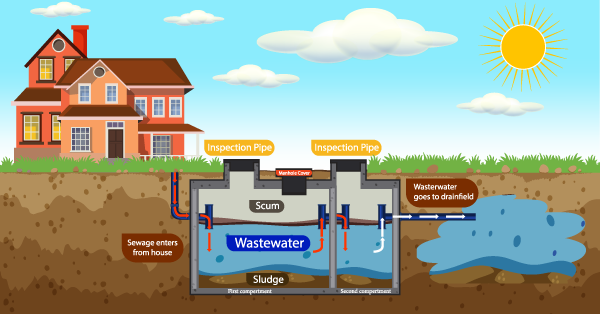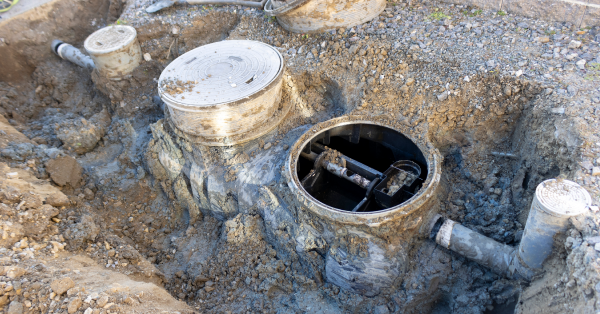Buying a House With a Septic Tank
- A home with a septic system won't be linked to a mains drainage system, and these properties are estimated to make up only around 5% of homes in the UK.
- Top Tip: Get a home buyer survey from an experienced RICS surveyor to ensure it is compliant, safe, and inspected thoroughly.
- The more rural a property is, the more likely it is that a septic tank is used as the self-contained sewage system. It should be declared in the TA6 Property Information Form.
A septic tank (or a cesspit), is often required for properties not connected to the mains drainage system. They have developed over time as a solution to homes that can't link up to their nearest drainage or sewage treatment plant.
It brings an added dimension to your pre-purchase checks because not only will you have to understand how the equipment works, but you'll need to be aware of the implications of its pollution to the local ecosystem.
How many septic tanks are in the UK?
Septic tanks are estimated to be attached to around 5% of houses in England & Wales. They're more common in other countries because the UK's housing is typically clustered in developments or areas in towns and cities, where their drainage system is linked up to a local sewage treatment plant.

What does off-mains drainage mean?
The vast majority of UK homes have a mains drainage system; waste water from sinks, washing machines, dishwashers, toilets, and bathrooms will flow into a public sewer.
Off-mains drainage is for properties not near a mains sewer, using either a septic tank or a cesspit (just a holding tank) as their self-contained treatment system.
Are you buying a house with a septic tank?
A house with a septic system is of non-standard construction and requires a full building survey with an experienced RICS surveyor.
Our surveyor network covers England and Wales with availability from 08/01/2026.* It is crucial to check the age, type, and location of the tank installed, as well as different requirements such as its compliance with regulations and the need for inspection records.
What is a septic tank?
It's a large underground container made of concrete, glass, or plastic that stores domestic sewage. Sometimes they have more than one chamber to separate liquid and solid waste, each with its own manhole cover and separated with a dividing wall.
Oil, grease, and lighter solids from the waste then build up to form a 'scum' layer whilst the heavier solids fall to the base of the tank, creating a 'sludge' layer. The septic system discharges the liquid between those two layers into a drainage system, usually an outlet pipe into a field where it's spread into the surrounding soil.
Are they similar to sewage treatment plants?
Sewage tanks are similar to sewage treatment plants; the main difference is a treatment plant cleans the wastewater and a tank discharges it directly into a watercourse (subject to the general binding rules).
How are septic tanks maintained?
Waste that is not discharged should be removed from the holding tank. The tank emptied regularly of the accumulated sludge at the bottom to ensure a well-maintained system.
Some systems require pumping or emptying every few years but an older domestic sewage treatment system with a small tank used by a large family would require much more frequent pumping.

How can septic tanks malfunction?
The issue is the rate of waste coming into the tank compared to how often the tank discharges, and the 'sludge' layer at the base of the tank building up.
The soakaway system often requires replacement and the frequency depends on the type of soil involved, with sandy soils lasting perhaps four times as long as clay. There were no Building Regulations or general binding rules about soakaways before 2000, but this is no longer the case.
If the tank discharges into a ditch or stream, even a small sewage discharge, this is illegal and always has been. All these discharge systems had to have been replaced by 1st January 2020. If it has not been replaced or upgraded, you must apply for a permit justifying why it isn't reasonable to do so. If the discharge causes pollution, you may be committing an offence and the Environment Agency can take enforcement action.
It's crucial to get a survey to catch this before buying a house with a septic tank; you could become liable for pollution offences when the property is transferred.
Surface water pollution can occur - this is why there are now rules that the water table is not allowed to get to within 2 metres of ground level.
Odour, gas emissions, and even undecomposed sewage can be discharged directly into the drainage field if the tank isn’t maintained properly - this can be down to cooking oils, grease, cigarettes, and water softeners attacking the useful microbes.
Excess nitrogen and phosphorus from the sewage can poison wild fish and other water life.
How do you know if you are buying a property with a septic system?
Generally, the more rural a property is, the more likely that a septic system will be used at least in part to dispose of sewage. It should be declared in the seller’s Property Information Form (TA6).
Additionally, if you buy the Water and Drainage Search, you will find that the property is not joined up to the main sewage system.
Pros and cons of owning a house with a septic tank
Pros
- Self-contained systems can reduce your monthly utility bills since you won't pay for sewer usage.
- Since wastewater is treated onsite, this reduces your environmental footprint and is considered more environmentally friendly than a large-scale sewer system.
- The independence of rural living can be attractive to some; if you're looking to buy a countryside home, you'll likely encounter a septic system.
- As long as it's well-maintained, an individual system can last for decades which ensures long-term reliability.
In our recent survey, 16% of homeowners found defects; including 2% who were able to pull out of a bad purchase, 7% who were able to negotiate a better price, and sadly, 7% of homeowners who did not get a survey and discovered defects after the purchase.
12 of the 39 who remembered how much these defects cost to remedy spent over £5,000
Don't burn your money, book a survey.

Cons
- Regular maintenance can prove costly because you need to pump out the tank every 3-5 years.
- Septic tanks can fail if not maintained properly, leading to costly repairs.
- If you're purchasing a property with a tank, you will need a thorough inspection by a qualified professional. This adds to the overall expenses of the purchase.
- Non-compliance with the government's binding rules can result in fines and compulsory upgrades.

Questions to ask when buying a house with a septic tank
When was the system last inspected and serviced?
Regular inspections and servicing are essential, so seeing the maintenance records will indicate how well the previous owners maintained the tank.
What is the age of the tank?
This will give you an idea of how soon you may need to replace the system, or if any repairs or replacements are coming up; older systems will be prone to issues but a newer one in good working order will not.
Is the tank compliant with the current regulations?
Make sure that you aren't hit with any unexpected fines.
Where is it located?
This will help you avoid accidental damage and plan for future landscaping opportunities.
How a septic tank could affect your negotiations
A house with a septic tank might justify a lower offer compared to other properties, especially if the system is older or requires immediate attention.
You could also include a system inspection as a contingency in your offer. If any significant issues are uncovered, you can negotiate repairs made by the seller before the purchase or request a price reduction to cover the costs.
If the current system is not compliant with the latest regulations, you could negotiate with the seller to bring them up to standard before finalising the sale.
Some insurance companies might charge a higher premium for homes with a septic system. You can factor this into your negotiations by including these potentially higher costs in your budget.
What are the government's general binding rules?
Since 2015, certain property owners in England and Wales with either a septic system or a small sewage treatment plant must register their systems and apply for a permit or qualify for an exemption with the Environment Agency.
The Environment Agency has set up Groundwater Source Protection Zones to protect drinking water abstracted from boreholes. If you are in Zone 1, you cannot have a new soakaway field there.
All new water soakaways must be in an area of the garden away from rainwater soakaways, not under drives, parking areas, or paths and at least 15 metres from any building and 2 metres from a boundary. As the average soakaway drain field takes up at least 100M², you can see that you need a massive garden to site a new one.

Your soil type for a soakaway cannot be either ‘too sandy or too heavy’: 60% of new sites fail these tests.
An experienced solicitor will analyse property searches - particularly the drainage search - heavily if a septic system is involved. Additionally, they will raise enquiries if a tank is mentioned in form TA6.
Need a full building survey?
Book one of our RICS-accredited surveyors to inspect the property throughout, using their years of specialist experience.
With availability from 08/01/2026*, we cover most of England and Wales.
Andrew started his career in 2000 working within conveyancing solicitor firms and grew hands-on knowledge of a wide variety of conveyancing challenges and solutions. After helping in excess of 50,000 clients in his career, he uses all this experience within his article writing for SAM, mainstream media and his self published book How to Buy a House Without Killing Anyone.
Caragh is an excellent writer and copy editor of books, news articles and editorials. She has written extensively for SAM for a variety of conveyancing, survey, property law and mortgage-related articles.









